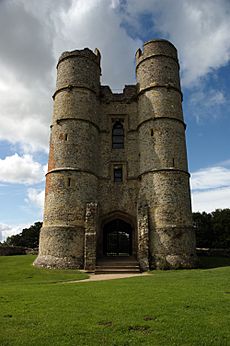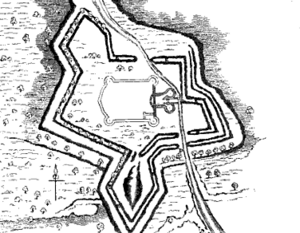Donnington Castle facts for kids
Quick facts for kids Donnington Castle |
|
|---|---|
| Near Donnington, Berkshire in England | |

Ruins of Donnington Castle
|
|
|
Shown within Berkshire
|
|
| Coordinates | 51°25′10″N 001°20′15″W / 51.41944°N 1.33750°W |
| Site information | |
| Owner | English Heritage |
| Condition | Ruins |
| Site history | |
| Built | 1386 |
| Built by | Sir Richard Abberbury the Elder |
| In use | 1386-1646 |
Donnington Castle is a ruined medieval castle. It is located in the small village of Donnington. This village is just north of Newbury in Berkshire, England.
Sir Richard Abberbury the Elder built the castle in 1386. Later, Thomas Chaucer bought it. The castle then came under royal control during the Tudor period. During the First English Civil War, Sir John Boys held the castle for the King. It survived a long 18-month attack. After the soldiers finally gave up, Parliament voted to demolish Donnington Castle in 1646.
Today, only the gatehouse still stands. English Heritage looks after the site. It is protected as a scheduled ancient monument.
Contents
Castle History: From Building to Battle
The Adderbury family owned the land where Donnington Castle stands since 1292. Sir Richard Abberbury the Elder built the castle in 1386. He received special permission, called a licence, from King Richard II. The impressive gatehouse you see today was built at this time.
In 1398, Sir Richard sold the castle to Thomas Chaucer. Thomas was the son of the famous poet Geoffrey Chaucer. Donnington Castle became a home for Thomas's daughter, Alice. She later became the Duchess of Suffolk. Her husband, William De La Pole, the Duke of Suffolk, lived there sometimes. He also made the castle buildings much larger.
Royal Ownership and Important Visitors
Later, the Suffolk family had disagreements with the Tudor kings and queens. Because of this, Donnington Castle became property of the royal family. In 1514, King Henry VIII gave it to Charles Brandon, 1st Duke of Suffolk. Brandon visited the castle in 1516. However, by 1535, when the castle returned to the Crown, it was starting to fall apart.
Several English monarchs visited Donnington Castle. King Henry VIII came in 1539. King Edward VI visited in 1552. Queen Elizabeth I came in 1568. In 1590, Queen Elizabeth I gave Elizabeth Cooke (Lady Russell) the job of looking after the castle. She was the first woman in England to have such a role.
The English Civil War and Demolition
In 1600, Queen Elizabeth I gave the castle to Charles Howard, 1st Earl of Nottingham. By the time the English Civil War began in 1643, the castle belonged to the Packer family. They supported Parliament. However, after the First Battle of Newbury, King Charles I's forces took control of the castle. Sir John Boys led the King's soldiers, known as Royalists.
The Royalists quickly made the castle stronger. They added earthworks, which are mounds of earth, in a star shape. These were used to place cannons. Parliament's army attacked the castle in October 1644. The soldiers inside held out for 18 months! With permission from the King, Sir John Boys finally surrendered the castle in April 1646. He and his men were allowed to leave safely.
In 1646, Parliament decided to destroy most of the castle. Only the gatehouse was left standing. However, you can still see the star-shaped earthworks from the 17th century. Today, English Heritage cares for the castle. It is protected as a scheduled ancient monument. The castle remained with the Packer family until the mid-1700s.
Castle Layout: What it Looked Like
Donnington Castle was originally built in a shape that was mostly rectangular. It had a strong outer wall, called a curtain wall. There was a round tower at each of the four corners. In the middle of the two walls running from west to east, there were two square towers.
Inside the curtain walls, there was a courtyard. This courtyard likely held a large hall, kitchens, and rooms for guests. The courtyard measured about 20.4 meters (67 feet) from north to south. It was about 32.9 meters (108 feet) from east to west.
Civil War Defences
During the Civil War, star-shaped earthworks were built around the castle. These were special mounds of earth designed for placing cannons. When the castle was destroyed in 1646, only the gatehouse survived. It still stands three storeys high. Inside, it measures about 5.3 meters (17.5 feet) by 3.6 meters (11.75 feet).
Today, low modern walls, about 0.5 meters (1.6 feet) high, show where the rest of the castle used to be. The star-shaped earthworks from the Civil War are still visible. They are about 1.7 meters (5.6 feet) high.
Gallery
-
Plan of the last Skirmish at Donnington Castle during the First English Civil War









